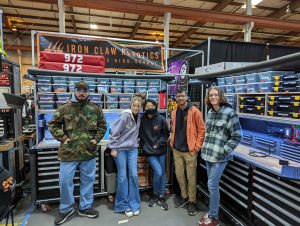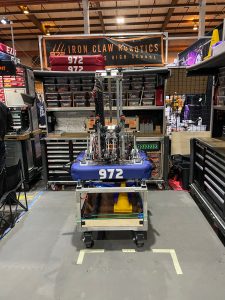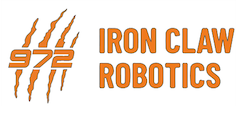 Last weekend, our team competed in our first competition at Hueneme Port Regional (also known as HPR) in Ventura Country, California. We chose to attend this Week 1 competition for the opportunity to test our robot early in the season and to learn from other teams’ designs. During the week leading up to the competition, the team focused on creating spares for the 4-bar arm and energy chain of the robot, and tested its auto routine in order to get ready for the competition.
Last weekend, our team competed in our first competition at Hueneme Port Regional (also known as HPR) in Ventura Country, California. We chose to attend this Week 1 competition for the opportunity to test our robot early in the season and to learn from other teams’ designs. During the week leading up to the competition, the team focused on creating spares for the 4-bar arm and energy chain of the robot, and tested its auto routine in order to get ready for the competition.
On the first day of competition, which was practice match day, we practiced driving our swerve drivetrain and controlling the superstructure mechanisms as well as tested several autonomous routines, including one which automatically balances the robot on the charge station. Meanwhile, the rest of our team toured the pits to scout other robots and collect data on unique and efficient designs. Additionally, several mechanical changes were made such as adding chain tensioners to reduce the four bar’s backlash. Another thing being worked on was the autonomous routine, we were trying to get a cone on the high node during auto. Within the first few practice matches, our drivers confirmed that although our robot could score cones, we could pick up and place cubes much more efficiently; this led us to revise our strategy to focus on forming links by placing cubes in hybrid nodes for speedy cycle times.
bar’s backlash. Another thing being worked on was the autonomous routine, we were trying to get a cone on the high node during auto. Within the first few practice matches, our drivers confirmed that although our robot could score cones, we could pick up and place cubes much more efficiently; this led us to revise our strategy to focus on forming links by placing cubes in hybrid nodes for speedy cycle times.
 During the first competition, our autonomous worked like we wanted it to, as we went on to put a cone in the middle node. As we moved on to teleop, we came up with several different strategies depending on our alliance members. Sometimes for our strategy, we decided to go for links and decided to only aim for cubes since our intake had mechanical limitations that made it difficult to intake cones. At the end of teleop, our alliance members went with us to the charge station and we managed to engage on the charge with three robots in order to get an extra ranking point. We were able to do this because we made the frame of the robot smaller than usual. During the remaining matches, we continued to focus on intaking cubes and going for fast cycle times in order to maximize the amount of points. In Quals 75, our team got a world record score with team 1678, Citrus Circuits, and team 498, The Cobra Commanders. Check out the video of Quals 75 here.
During the first competition, our autonomous worked like we wanted it to, as we went on to put a cone in the middle node. As we moved on to teleop, we came up with several different strategies depending on our alliance members. Sometimes for our strategy, we decided to go for links and decided to only aim for cubes since our intake had mechanical limitations that made it difficult to intake cones. At the end of teleop, our alliance members went with us to the charge station and we managed to engage on the charge with three robots in order to get an extra ranking point. We were able to do this because we made the frame of the robot smaller than usual. During the remaining matches, we continued to focus on intaking cubes and going for fast cycle times in order to maximize the amount of points. In Quals 75, our team got a world record score with team 1678, Citrus Circuits, and team 498, The Cobra Commanders. Check out the video of Quals 75 here.

On the second day of competition, our team remained strong as we started to improve the autonomous routine. We tested more autonomous routines and were able to score a cone on the high node by extending the elevator and the 4-bar arm. Moreover, our human player discovered a way to drop a cone from a single substation and still have it land right side up. This was done through trial and error by the human player. Our team made it to the playoffs, ending in 5th place, and picked team 687, the Nerd Herds, and team 2429, La Cañada Engineering Club, to be in our alliance. After winning our first match, we lost during match 7 of the playoffs. We had to make repairs to our energy chain due to the broken mount, since we were in a rush, we resorted to zip tying it together for several matches.
After the competition, we plan on making repairs to this energy chain and also making it stronger than before, which we will replace with spares. We also are planning on redesigning the intake for a more efficient cycle time where we can also intake cones from the shelf, caused by trouble with intaking the cone. Overall, Port Hueneme was a success and we will continue to refine our design and strategy for the upcoming competitions.

